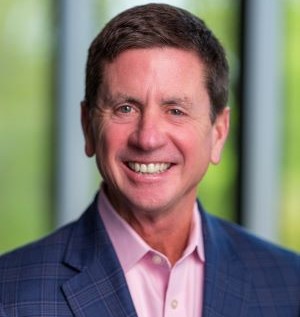 Prevue sat down with Maritz COO, Business Events Solutions, to find out what he sees coming down the pike on everything from AI for events to sustainability.
Prevue sat down with Maritz COO, Business Events Solutions, to find out what he sees coming down the pike on everything from AI for events to sustainability.
Steve O’Malley, COO, Business Events Solutions with Maritz, is in the catbird seat when it comes to trends in engagement and all things business events. The experience design company had just released a special edition of its Industry Trends report at IMEX America 2023 in Las Vegas in October when Prevue had the opportunity to sit down with O’Malley to learn more about what his company is seeing as the meetings industry continues to recover from the pandemic.
Here are a few highlights from that conversation.

AI: Artificial intelligence is the new buzzword when it comes to meetings and events, but, O’Malley said, we’re still just at the beginning of our AI journey. “There are no experts yet — we’re all just starting to explore the potential,” he said. And that potential could be massive, particularly in the newest iteration of generative AI that analyzes data patterns to create something new, he added. One area where AI could really make a difference is in air travel, especially in times like the present where capacity is constrained — “AI can help with itineraries and ticketing to optimize resources,” he said. It also could be helpful in sourcing destinations and providing personalized options for everything from sessions to guest rooms.
But those are just a few small examples of where AI can be applied to the business events industry, he added. “We do more than 6,500 events per year — how can we use AI to free up time so we can put more of our energy into event design?” A few examples could be using AI prompts to get the creative juices flowing for content, session titles, themes and imagery, or even to create session summaries.
AI also could be a boon for suggesting connections for matchmaking, which is especially vital for the newest generation joining the workforce, O’Malley said. And it also could provide data insights that could help planners track everything from registration pacing to housing pickup to the event’s carbon footprint.
Sustainability. While this has been a focus for a long time now, O’Malley said the pace is really picking up now, especially in the healthcare industry. “Because their primary goal is to improve people’s health and lives, they see it as their duty to reduce their event’s carbon footprint.” Some in the healthcare vertical are even tying their executive’s compensation to the organization’s sustainability goals, and that is causing ripple effects in their meetings as well. For example, if an organization has used up its carbon allotment for the year, it may cancel those last few meetings of the year or hold them locally or regionally.
“I think that’s the tip of the spear,” O’Malley added. “We’re seeing an increase in the number of clients where sustainability is written into their missions — and into their events. We’re going to see more industry verticals strengthening their focus on sustainability, even requiring venues to have a specific sustainability score to qualify to receive an RFP.”
However, he cautioned, the intensity of the sustainability focus still varies from client to client. “We’re focusing on educating our entire populace so every plan is approached in a way that adheres to best practices.” Noting that Maritz has signed the Net Zero Carbon Events Pledge, sustainability “will be part of who we are moving forward.”
Recovery in 2023. Business at Maritz is back and booming, he reported. They did prune back some accounts during the pandemic that no longer made good business sense, helping those clients transition to alternate solutions. The company since has added new accounts and, while “there’s probably some residual fatigue for those who made it through COVID, we’re as fully recovered as we can be after having gone through something so devastating.”
Given that Maritz’s latest trends report outlines a continuing hit to the events business by stagnant inflation that continues to have an outsize effect on meeting budgets, “The biggest challenges our clients face is creating the experiences that are required for the objectives that they have. Considering the amount of inflation that’s occurred, that is a creative challenge that we all face to achieve those objectives with limited funds.”
Virtual and hybrid events in 2023. While there has been a rush back to face-to-face events, virtual and hybrid do still have a role to play, he said. There still are corporations that are substituting some in-person meetings with the digital options everyone became accustomed to during the depths of the pandemic. While it would be great if business travel came back full strength, which would mean airlines would have to increase capacity, which would help ease the strain for meetings and events, O’Malley thinks the reduction may last a while, or possibly be permanent. “It may be too difficult for some CFOs who saved a billion dollars by shutting down business travel for a year to go back to spending a billion dollars a year on business travel.”
But, he added, “If you’ve had the option to come and experience an event like IMEX, as opposed to having some sort of virtual experience — there’s no substitute for that.”
That may be why Maritz’s virtual business has gone close to zero, especially on the corporate side. Association trade shows are also trending in that direction, he said, because the expense associated with holding two simultaneous or concurrent events — one in-person and one digital — can end up being a revenue loser.
Engagement at events. Digital may be fine for one-way information-only sessions, but there’s no substitute for those serendipitous connections that only happen at in-person events. The key is to enable attendees to be the authors of the events, to give them agency over how they consume the experience, he said. “You don’t want to have things at the event being done for people. You want events being done with people. The last three years have taught people where their margins are — they want to have a sense of choice over their experience.
“There’s another element where AI is going to help. We can use it to figure out how to solicit the kind of feedback we need to develop a more meaningful experience, to make it as personalized and meaningful as possible. We need to be willing to ask the questions and then willing to incorporate the feedback we’re getting. That’s available to us as an industry.”
One way to do that is to build more margin into the daily agenda so that people have more opportunity to self-select how they want to interact with others so they can have more of those serendipitous encounters that sometimes are the most meaningful things that person walks away with, he said.
“When we, as an industry, develop an event that allows for those moments of poignancy. Where we’re at our best is creating moments that make you long for the event to last longer and sad that it has to end. That’s what makes the hair on the back of your neck stand up. It could be serendipitous or it could be planned. It could be the band that you’re hearing final night, or it could just be seeing someone you haven’t seen in a long time, or it could be finding exactly the person you need to get the answer to your most burning question.”
He added, “It’s a really tough challenge, but doing the same old agenda from seven in the morning till five in the evening, and then straight into bed and then doing it all over again…that’s no longer going to work.”
Wellness at events. The focus on wellness, which already was gaining traction pre-pandemic, is only going to continue to grow, O’Malley predicted. “We have to find opportunities for people to be as healthy as they choose. And that means mental health as well as physical.
“We have a lot of work to do. It’s an exciting time for our industry, and it’s going get better and better.”
You May Also Be Interested In…
Global Business Travel Forecast: High Demand, Rising Costs
Meeting Planner Pain Points: Inflation, Hidden Fees, Service Gaps and More
Growth Streak to Continue for Incentive Travel










